Financial Performance: Business Review and Financial Analysis
VerifiedAdded on 2023/06/12
|12
|2584
|495
Report
AI Summary
This report provides a comprehensive overview of financial management, starting with the definition and importance of financial management within a business context. It explores key aspects such as increasing profitability, motivating employee savings, minimizing costs, adding value, and allocating scarce resources. The report then delves into financial statements, including cash flow, income, and balance sheets, and explains the use of financial ratios in assessing profitability, financial risk, and future planning. A case study is utilized to demonstrate the application of profitability, liquidity, and efficiency ratios, interpreting results to suggest improvements like overhead cost reduction and better debt management. Finally, the report discusses strategies for enhancing financial performance, such as effective marketing, resource allocation, and inventory management, emphasizing the importance of monitoring and improving key financial metrics. The report concludes that financial management is essential for the growth and success of any business organization.

Business Finance
Paraphrase This Document
Need a fresh take? Get an instant paraphrase of this document with our AI Paraphraser
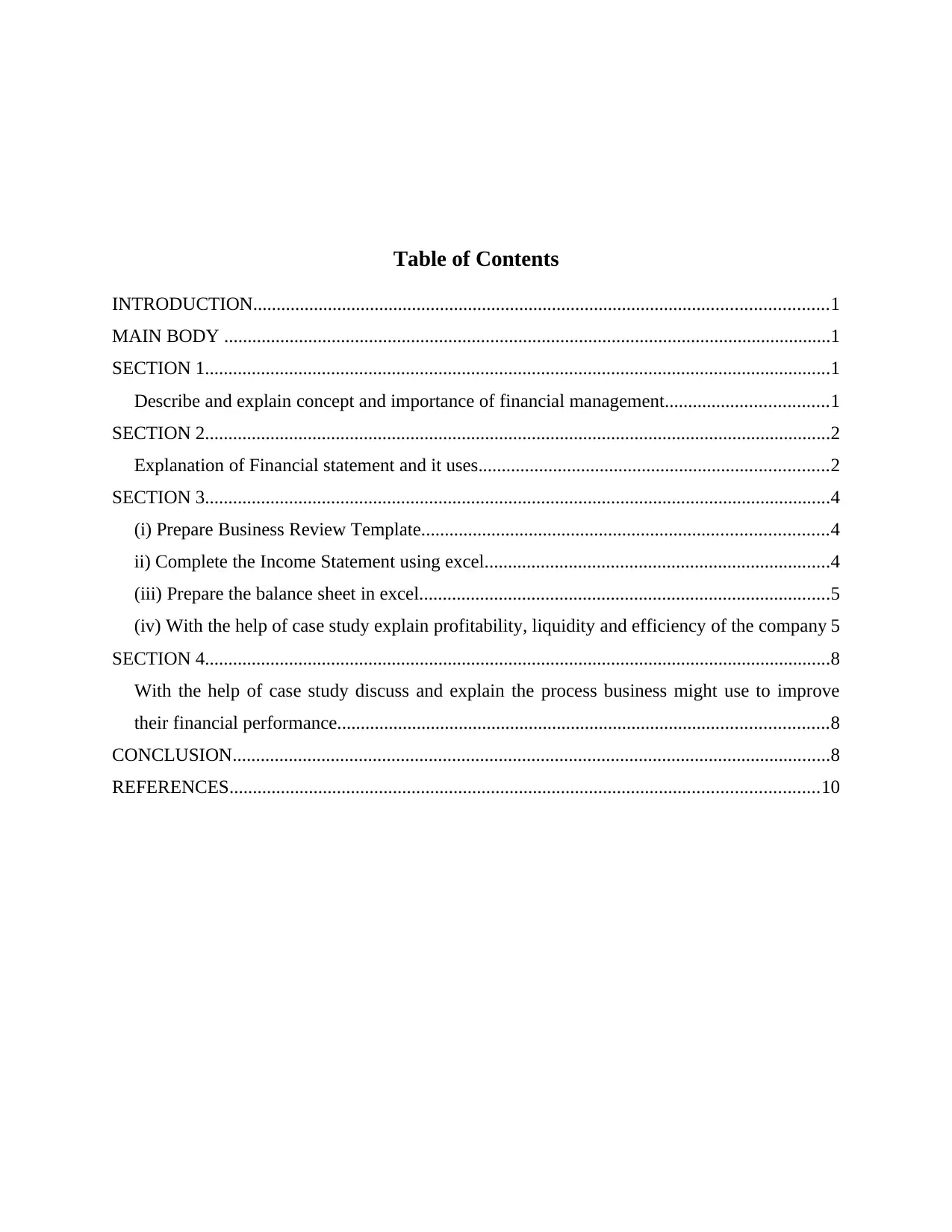
Table of Contents
INTRODUCTION...........................................................................................................................1
MAIN BODY ..................................................................................................................................1
SECTION 1......................................................................................................................................1
Describe and explain concept and importance of financial management...................................1
SECTION 2......................................................................................................................................2
Explanation of Financial statement and it uses...........................................................................2
SECTION 3......................................................................................................................................4
(i) Prepare Business Review Template.......................................................................................4
ii) Complete the Income Statement using excel..........................................................................4
(iii) Prepare the balance sheet in excel........................................................................................5
(iv) With the help of case study explain profitability, liquidity and efficiency of the company 5
SECTION 4......................................................................................................................................8
With the help of case study discuss and explain the process business might use to improve
their financial performance.........................................................................................................8
CONCLUSION................................................................................................................................8
REFERENCES..............................................................................................................................10
INTRODUCTION...........................................................................................................................1
MAIN BODY ..................................................................................................................................1
SECTION 1......................................................................................................................................1
Describe and explain concept and importance of financial management...................................1
SECTION 2......................................................................................................................................2
Explanation of Financial statement and it uses...........................................................................2
SECTION 3......................................................................................................................................4
(i) Prepare Business Review Template.......................................................................................4
ii) Complete the Income Statement using excel..........................................................................4
(iii) Prepare the balance sheet in excel........................................................................................5
(iv) With the help of case study explain profitability, liquidity and efficiency of the company 5
SECTION 4......................................................................................................................................8
With the help of case study discuss and explain the process business might use to improve
their financial performance.........................................................................................................8
CONCLUSION................................................................................................................................8
REFERENCES..............................................................................................................................10
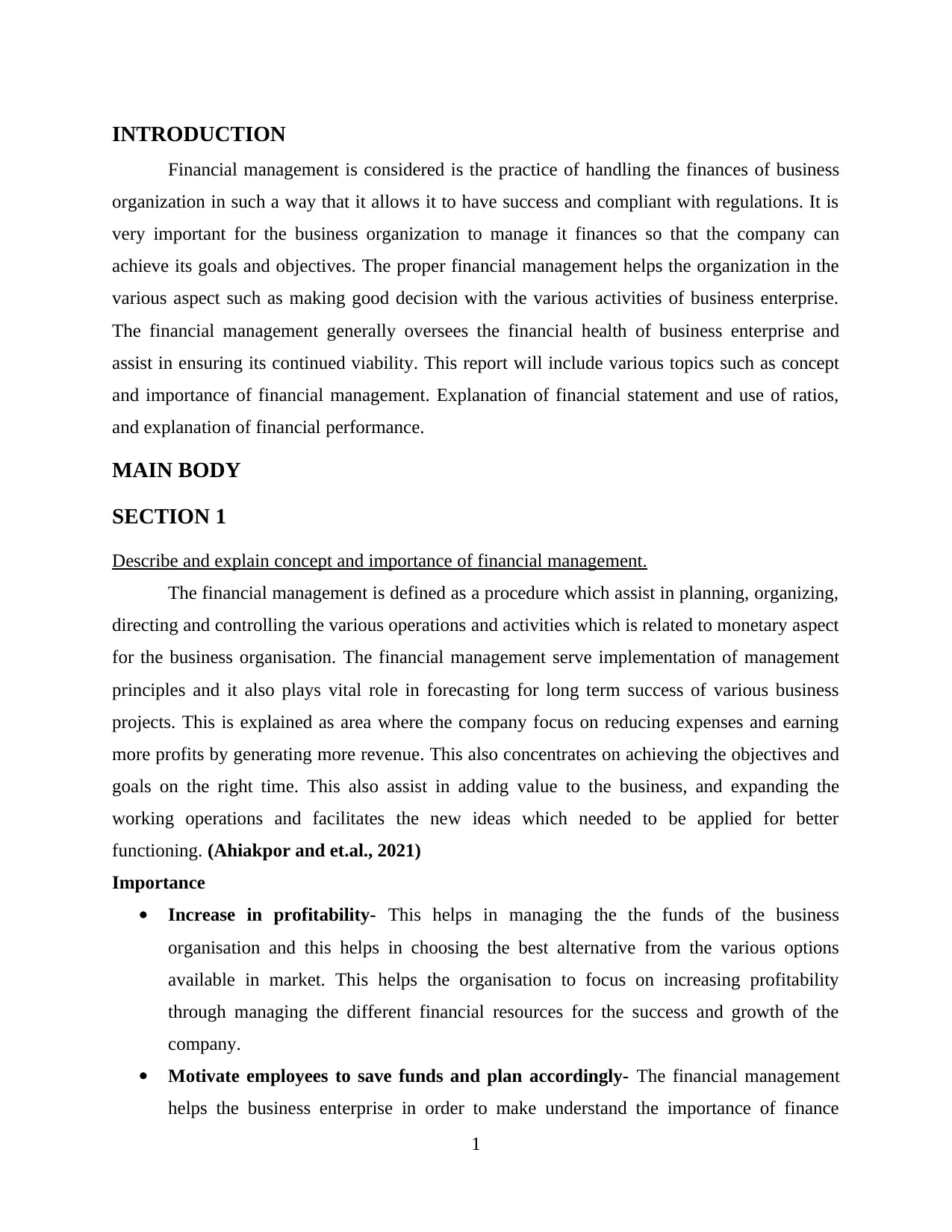
INTRODUCTION
Financial management is considered is the practice of handling the finances of business
organization in such a way that it allows it to have success and compliant with regulations. It is
very important for the business organization to manage it finances so that the company can
achieve its goals and objectives. The proper financial management helps the organization in the
various aspect such as making good decision with the various activities of business enterprise.
The financial management generally oversees the financial health of business enterprise and
assist in ensuring its continued viability. This report will include various topics such as concept
and importance of financial management. Explanation of financial statement and use of ratios,
and explanation of financial performance.
MAIN BODY
SECTION 1
Describe and explain concept and importance of financial management.
The financial management is defined as a procedure which assist in planning, organizing,
directing and controlling the various operations and activities which is related to monetary aspect
for the business organisation. The financial management serve implementation of management
principles and it also plays vital role in forecasting for long term success of various business
projects. This is explained as area where the company focus on reducing expenses and earning
more profits by generating more revenue. This also concentrates on achieving the objectives and
goals on the right time. This also assist in adding value to the business, and expanding the
working operations and facilitates the new ideas which needed to be applied for better
functioning. (Ahiakpor and et.al., 2021)
Importance
Increase in profitability- This helps in managing the the funds of the business
organisation and this helps in choosing the best alternative from the various options
available in market. This helps the organisation to focus on increasing profitability
through managing the different financial resources for the success and growth of the
company.
Motivate employees to save funds and plan accordingly- The financial management
helps the business enterprise in order to make understand the importance of finance
1
Financial management is considered is the practice of handling the finances of business
organization in such a way that it allows it to have success and compliant with regulations. It is
very important for the business organization to manage it finances so that the company can
achieve its goals and objectives. The proper financial management helps the organization in the
various aspect such as making good decision with the various activities of business enterprise.
The financial management generally oversees the financial health of business enterprise and
assist in ensuring its continued viability. This report will include various topics such as concept
and importance of financial management. Explanation of financial statement and use of ratios,
and explanation of financial performance.
MAIN BODY
SECTION 1
Describe and explain concept and importance of financial management.
The financial management is defined as a procedure which assist in planning, organizing,
directing and controlling the various operations and activities which is related to monetary aspect
for the business organisation. The financial management serve implementation of management
principles and it also plays vital role in forecasting for long term success of various business
projects. This is explained as area where the company focus on reducing expenses and earning
more profits by generating more revenue. This also concentrates on achieving the objectives and
goals on the right time. This also assist in adding value to the business, and expanding the
working operations and facilitates the new ideas which needed to be applied for better
functioning. (Ahiakpor and et.al., 2021)
Importance
Increase in profitability- This helps in managing the the funds of the business
organisation and this helps in choosing the best alternative from the various options
available in market. This helps the organisation to focus on increasing profitability
through managing the different financial resources for the success and growth of the
company.
Motivate employees to save funds and plan accordingly- The financial management
helps the business enterprise in order to make understand the importance of finance
1
⊘ This is a preview!⊘
Do you want full access?
Subscribe today to unlock all pages.

Trusted by 1+ million students worldwide
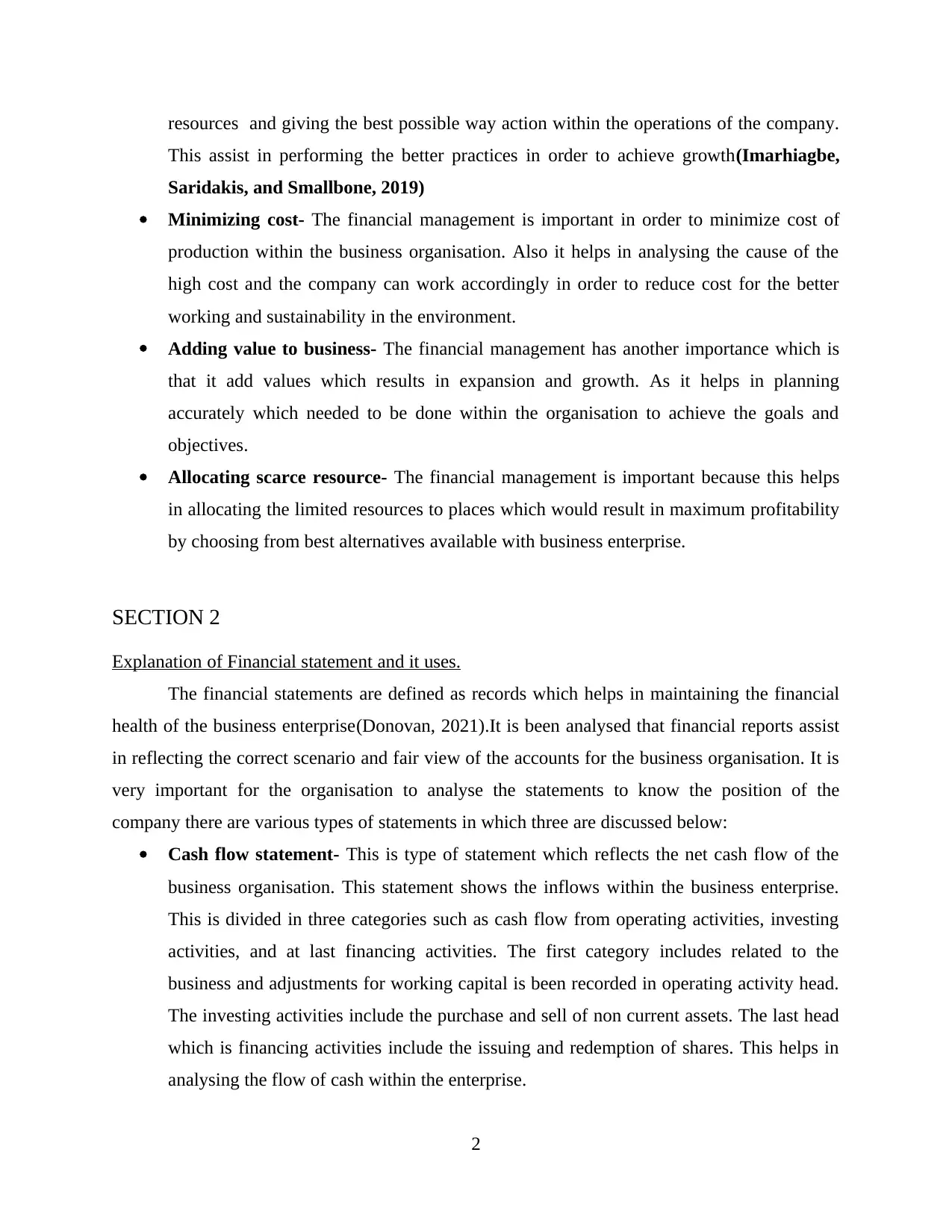
resources and giving the best possible way action within the operations of the company.
This assist in performing the better practices in order to achieve growth(Imarhiagbe,
Saridakis, and Smallbone, 2019)
Minimizing cost- The financial management is important in order to minimize cost of
production within the business organisation. Also it helps in analysing the cause of the
high cost and the company can work accordingly in order to reduce cost for the better
working and sustainability in the environment.
Adding value to business- The financial management has another importance which is
that it add values which results in expansion and growth. As it helps in planning
accurately which needed to be done within the organisation to achieve the goals and
objectives.
Allocating scarce resource- The financial management is important because this helps
in allocating the limited resources to places which would result in maximum profitability
by choosing from best alternatives available with business enterprise.
SECTION 2
Explanation of Financial statement and it uses.
The financial statements are defined as records which helps in maintaining the financial
health of the business enterprise(Donovan, 2021).It is been analysed that financial reports assist
in reflecting the correct scenario and fair view of the accounts for the business organisation. It is
very important for the organisation to analyse the statements to know the position of the
company there are various types of statements in which three are discussed below:
Cash flow statement- This is type of statement which reflects the net cash flow of the
business organisation. This statement shows the inflows within the business enterprise.
This is divided in three categories such as cash flow from operating activities, investing
activities, and at last financing activities. The first category includes related to the
business and adjustments for working capital is been recorded in operating activity head.
The investing activities include the purchase and sell of non current assets. The last head
which is financing activities include the issuing and redemption of shares. This helps in
analysing the flow of cash within the enterprise.
2
This assist in performing the better practices in order to achieve growth(Imarhiagbe,
Saridakis, and Smallbone, 2019)
Minimizing cost- The financial management is important in order to minimize cost of
production within the business organisation. Also it helps in analysing the cause of the
high cost and the company can work accordingly in order to reduce cost for the better
working and sustainability in the environment.
Adding value to business- The financial management has another importance which is
that it add values which results in expansion and growth. As it helps in planning
accurately which needed to be done within the organisation to achieve the goals and
objectives.
Allocating scarce resource- The financial management is important because this helps
in allocating the limited resources to places which would result in maximum profitability
by choosing from best alternatives available with business enterprise.
SECTION 2
Explanation of Financial statement and it uses.
The financial statements are defined as records which helps in maintaining the financial
health of the business enterprise(Donovan, 2021).It is been analysed that financial reports assist
in reflecting the correct scenario and fair view of the accounts for the business organisation. It is
very important for the organisation to analyse the statements to know the position of the
company there are various types of statements in which three are discussed below:
Cash flow statement- This is type of statement which reflects the net cash flow of the
business organisation. This statement shows the inflows within the business enterprise.
This is divided in three categories such as cash flow from operating activities, investing
activities, and at last financing activities. The first category includes related to the
business and adjustments for working capital is been recorded in operating activity head.
The investing activities include the purchase and sell of non current assets. The last head
which is financing activities include the issuing and redemption of shares. This helps in
analysing the flow of cash within the enterprise.
2
Paraphrase This Document
Need a fresh take? Get an instant paraphrase of this document with our AI Paraphraser
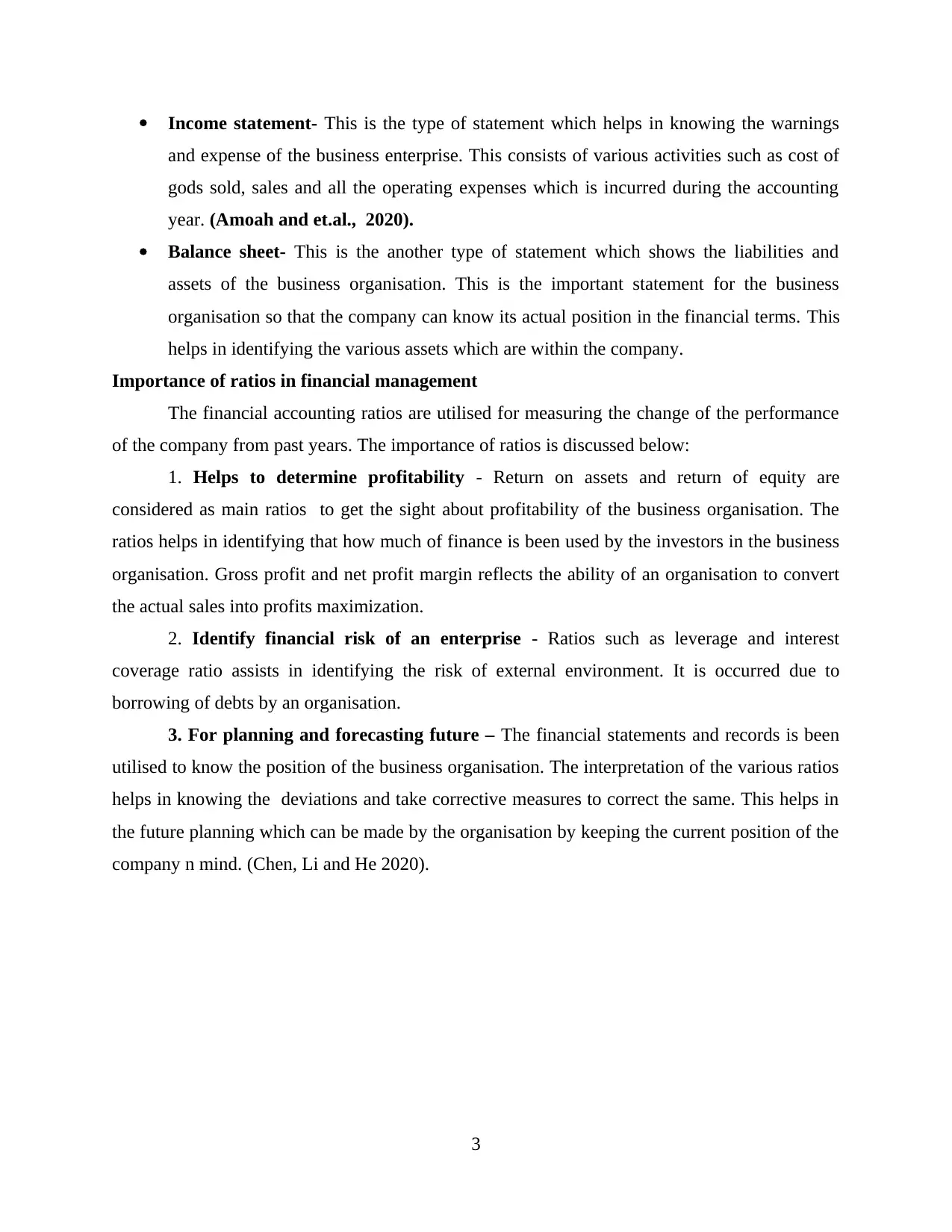
Income statement- This is the type of statement which helps in knowing the warnings
and expense of the business enterprise. This consists of various activities such as cost of
gods sold, sales and all the operating expenses which is incurred during the accounting
year. (Amoah and et.al., 2020).
Balance sheet- This is the another type of statement which shows the liabilities and
assets of the business organisation. This is the important statement for the business
organisation so that the company can know its actual position in the financial terms. This
helps in identifying the various assets which are within the company.
Importance of ratios in financial management
The financial accounting ratios are utilised for measuring the change of the performance
of the company from past years. The importance of ratios is discussed below:
1. Helps to determine profitability - Return on assets and return of equity are
considered as main ratios to get the sight about profitability of the business organisation. The
ratios helps in identifying that how much of finance is been used by the investors in the business
organisation. Gross profit and net profit margin reflects the ability of an organisation to convert
the actual sales into profits maximization.
2. Identify financial risk of an enterprise - Ratios such as leverage and interest
coverage ratio assists in identifying the risk of external environment. It is occurred due to
borrowing of debts by an organisation.
3. For planning and forecasting future – The financial statements and records is been
utilised to know the position of the business organisation. The interpretation of the various ratios
helps in knowing the deviations and take corrective measures to correct the same. This helps in
the future planning which can be made by the organisation by keeping the current position of the
company n mind. (Chen, Li and He 2020).
3
and expense of the business enterprise. This consists of various activities such as cost of
gods sold, sales and all the operating expenses which is incurred during the accounting
year. (Amoah and et.al., 2020).
Balance sheet- This is the another type of statement which shows the liabilities and
assets of the business organisation. This is the important statement for the business
organisation so that the company can know its actual position in the financial terms. This
helps in identifying the various assets which are within the company.
Importance of ratios in financial management
The financial accounting ratios are utilised for measuring the change of the performance
of the company from past years. The importance of ratios is discussed below:
1. Helps to determine profitability - Return on assets and return of equity are
considered as main ratios to get the sight about profitability of the business organisation. The
ratios helps in identifying that how much of finance is been used by the investors in the business
organisation. Gross profit and net profit margin reflects the ability of an organisation to convert
the actual sales into profits maximization.
2. Identify financial risk of an enterprise - Ratios such as leverage and interest
coverage ratio assists in identifying the risk of external environment. It is occurred due to
borrowing of debts by an organisation.
3. For planning and forecasting future – The financial statements and records is been
utilised to know the position of the business organisation. The interpretation of the various ratios
helps in knowing the deviations and take corrective measures to correct the same. This helps in
the future planning which can be made by the organisation by keeping the current position of the
company n mind. (Chen, Li and He 2020).
3
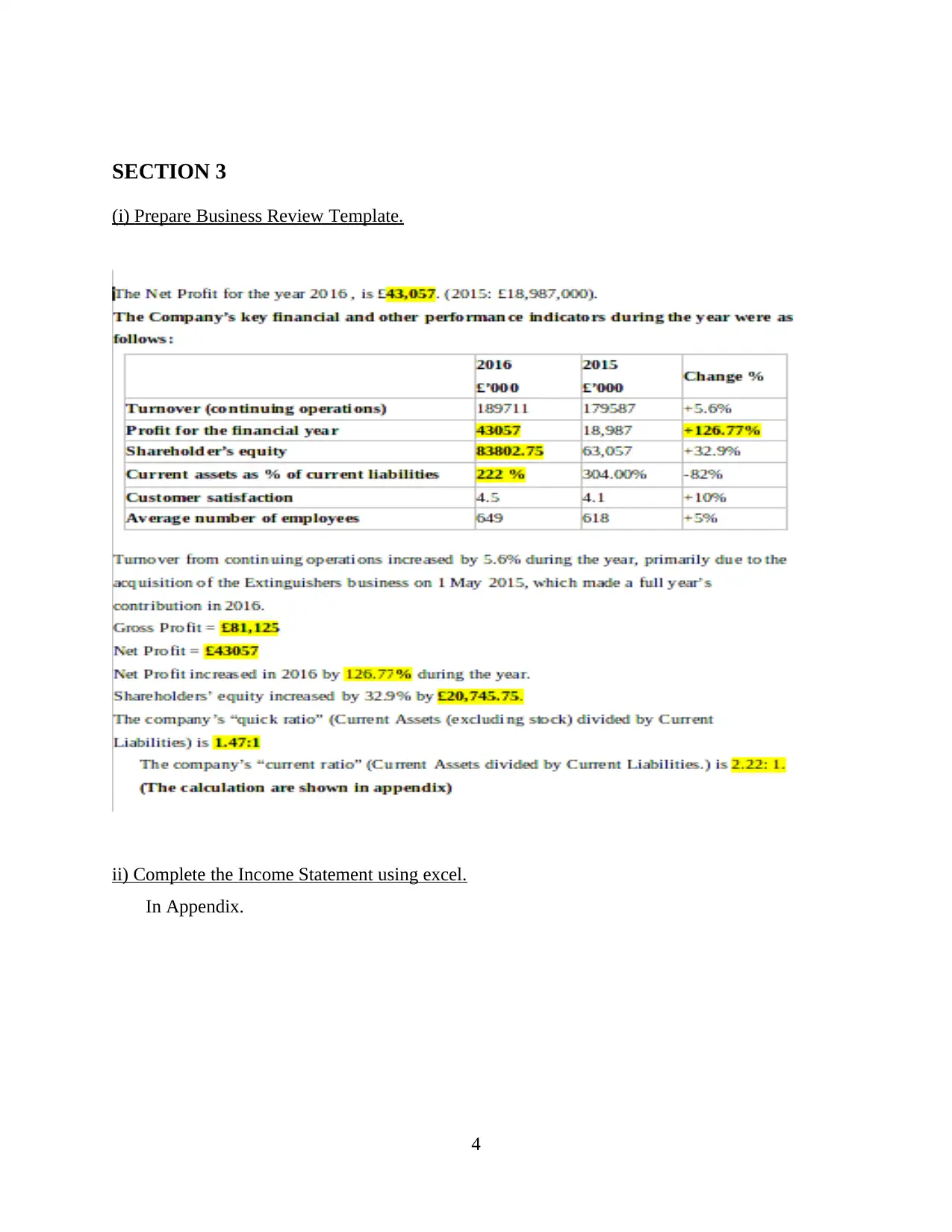
SECTION 3
(i) Prepare Business Review Template.
ii) Complete the Income Statement using excel.
In Appendix.
4
(i) Prepare Business Review Template.
ii) Complete the Income Statement using excel.
In Appendix.
4
⊘ This is a preview!⊘
Do you want full access?
Subscribe today to unlock all pages.

Trusted by 1+ million students worldwide
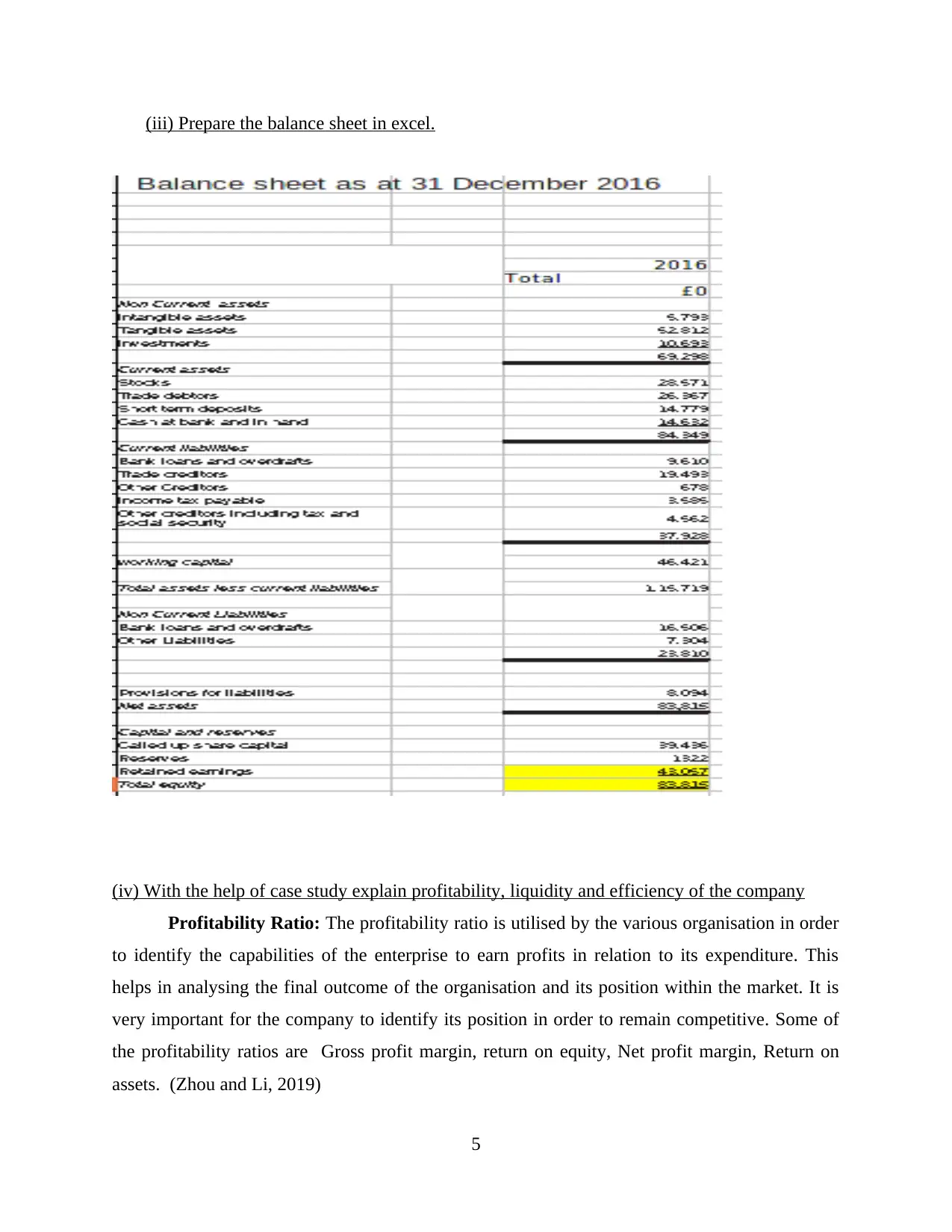
(iii) Prepare the balance sheet in excel.
(iv) With the help of case study explain profitability, liquidity and efficiency of the company
Profitability Ratio: The profitability ratio is utilised by the various organisation in order
to identify the capabilities of the enterprise to earn profits in relation to its expenditure. This
helps in analysing the final outcome of the organisation and its position within the market. It is
very important for the company to identify its position in order to remain competitive. Some of
the profitability ratios are Gross profit margin, return on equity, Net profit margin, Return on
assets. (Zhou and Li, 2019)
5
(iv) With the help of case study explain profitability, liquidity and efficiency of the company
Profitability Ratio: The profitability ratio is utilised by the various organisation in order
to identify the capabilities of the enterprise to earn profits in relation to its expenditure. This
helps in analysing the final outcome of the organisation and its position within the market. It is
very important for the company to identify its position in order to remain competitive. Some of
the profitability ratios are Gross profit margin, return on equity, Net profit margin, Return on
assets. (Zhou and Li, 2019)
5
Paraphrase This Document
Need a fresh take? Get an instant paraphrase of this document with our AI Paraphraser
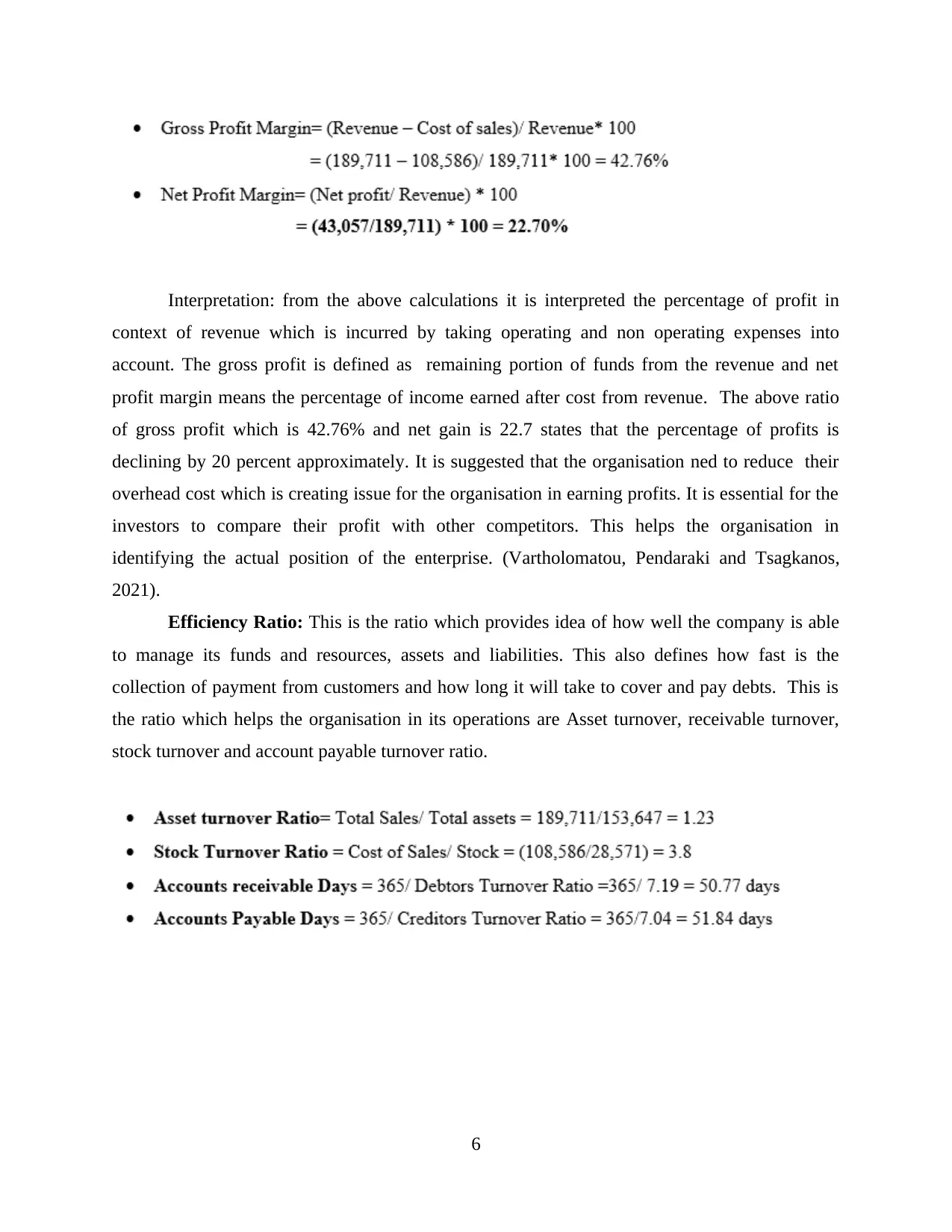
Interpretation: from the above calculations it is interpreted the percentage of profit in
context of revenue which is incurred by taking operating and non operating expenses into
account. The gross profit is defined as remaining portion of funds from the revenue and net
profit margin means the percentage of income earned after cost from revenue. The above ratio
of gross profit which is 42.76% and net gain is 22.7 states that the percentage of profits is
declining by 20 percent approximately. It is suggested that the organisation ned to reduce their
overhead cost which is creating issue for the organisation in earning profits. It is essential for the
investors to compare their profit with other competitors. This helps the organisation in
identifying the actual position of the enterprise. (Vartholomatou, Pendaraki and Tsagkanos,
2021).
Efficiency Ratio: This is the ratio which provides idea of how well the company is able
to manage its funds and resources, assets and liabilities. This also defines how fast is the
collection of payment from customers and how long it will take to cover and pay debts. This is
the ratio which helps the organisation in its operations are Asset turnover, receivable turnover,
stock turnover and account payable turnover ratio.
6
context of revenue which is incurred by taking operating and non operating expenses into
account. The gross profit is defined as remaining portion of funds from the revenue and net
profit margin means the percentage of income earned after cost from revenue. The above ratio
of gross profit which is 42.76% and net gain is 22.7 states that the percentage of profits is
declining by 20 percent approximately. It is suggested that the organisation ned to reduce their
overhead cost which is creating issue for the organisation in earning profits. It is essential for the
investors to compare their profit with other competitors. This helps the organisation in
identifying the actual position of the enterprise. (Vartholomatou, Pendaraki and Tsagkanos,
2021).
Efficiency Ratio: This is the ratio which provides idea of how well the company is able
to manage its funds and resources, assets and liabilities. This also defines how fast is the
collection of payment from customers and how long it will take to cover and pay debts. This is
the ratio which helps the organisation in its operations are Asset turnover, receivable turnover,
stock turnover and account payable turnover ratio.
6
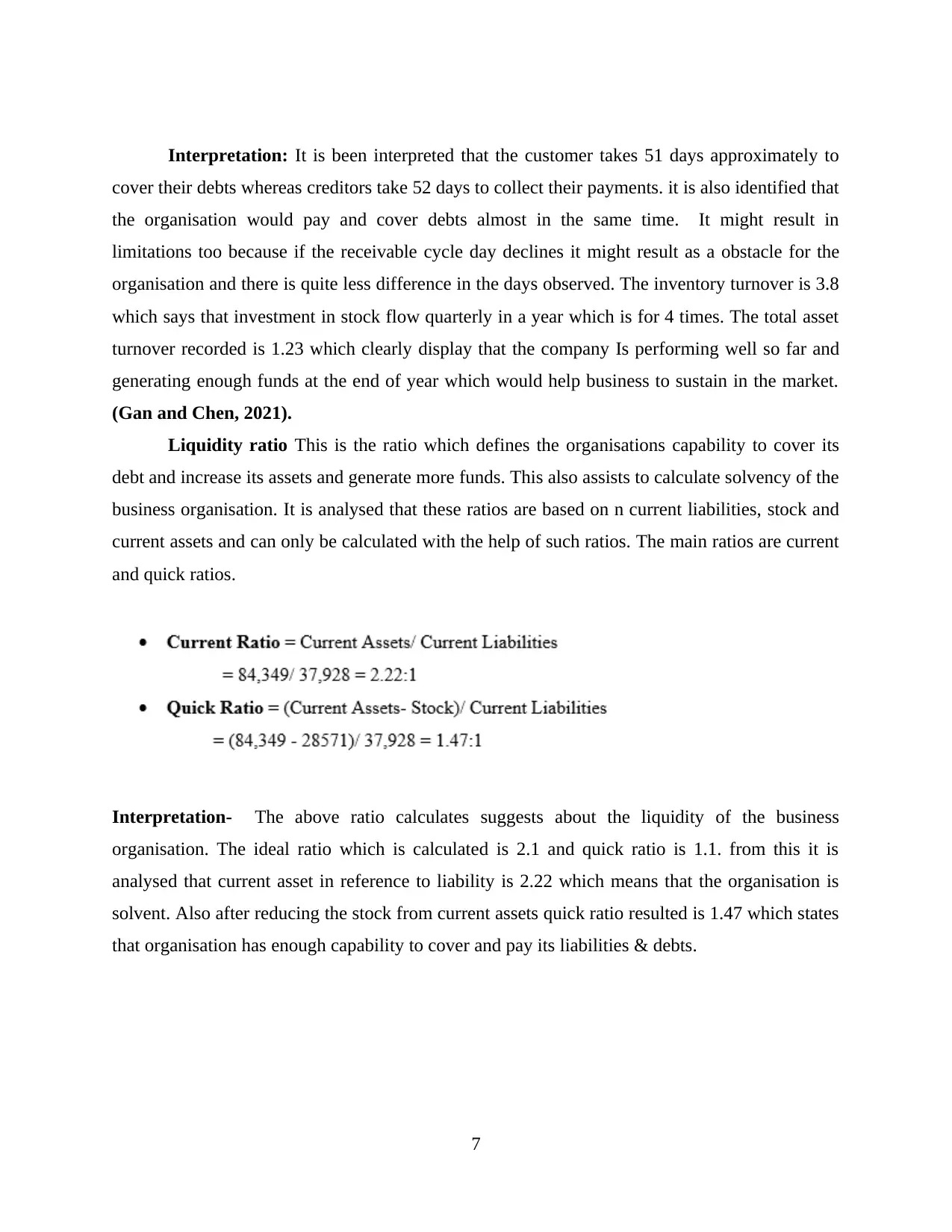
Interpretation: It is been interpreted that the customer takes 51 days approximately to
cover their debts whereas creditors take 52 days to collect their payments. it is also identified that
the organisation would pay and cover debts almost in the same time. It might result in
limitations too because if the receivable cycle day declines it might result as a obstacle for the
organisation and there is quite less difference in the days observed. The inventory turnover is 3.8
which says that investment in stock flow quarterly in a year which is for 4 times. The total asset
turnover recorded is 1.23 which clearly display that the company Is performing well so far and
generating enough funds at the end of year which would help business to sustain in the market.
(Gan and Chen, 2021).
Liquidity ratio This is the ratio which defines the organisations capability to cover its
debt and increase its assets and generate more funds. This also assists to calculate solvency of the
business organisation. It is analysed that these ratios are based on n current liabilities, stock and
current assets and can only be calculated with the help of such ratios. The main ratios are current
and quick ratios.
Interpretation- The above ratio calculates suggests about the liquidity of the business
organisation. The ideal ratio which is calculated is 2.1 and quick ratio is 1.1. from this it is
analysed that current asset in reference to liability is 2.22 which means that the organisation is
solvent. Also after reducing the stock from current assets quick ratio resulted is 1.47 which states
that organisation has enough capability to cover and pay its liabilities & debts.
7
cover their debts whereas creditors take 52 days to collect their payments. it is also identified that
the organisation would pay and cover debts almost in the same time. It might result in
limitations too because if the receivable cycle day declines it might result as a obstacle for the
organisation and there is quite less difference in the days observed. The inventory turnover is 3.8
which says that investment in stock flow quarterly in a year which is for 4 times. The total asset
turnover recorded is 1.23 which clearly display that the company Is performing well so far and
generating enough funds at the end of year which would help business to sustain in the market.
(Gan and Chen, 2021).
Liquidity ratio This is the ratio which defines the organisations capability to cover its
debt and increase its assets and generate more funds. This also assists to calculate solvency of the
business organisation. It is analysed that these ratios are based on n current liabilities, stock and
current assets and can only be calculated with the help of such ratios. The main ratios are current
and quick ratios.
Interpretation- The above ratio calculates suggests about the liquidity of the business
organisation. The ideal ratio which is calculated is 2.1 and quick ratio is 1.1. from this it is
analysed that current asset in reference to liability is 2.22 which means that the organisation is
solvent. Also after reducing the stock from current assets quick ratio resulted is 1.47 which states
that organisation has enough capability to cover and pay its liabilities & debts.
7
⊘ This is a preview!⊘
Do you want full access?
Subscribe today to unlock all pages.

Trusted by 1+ million students worldwide
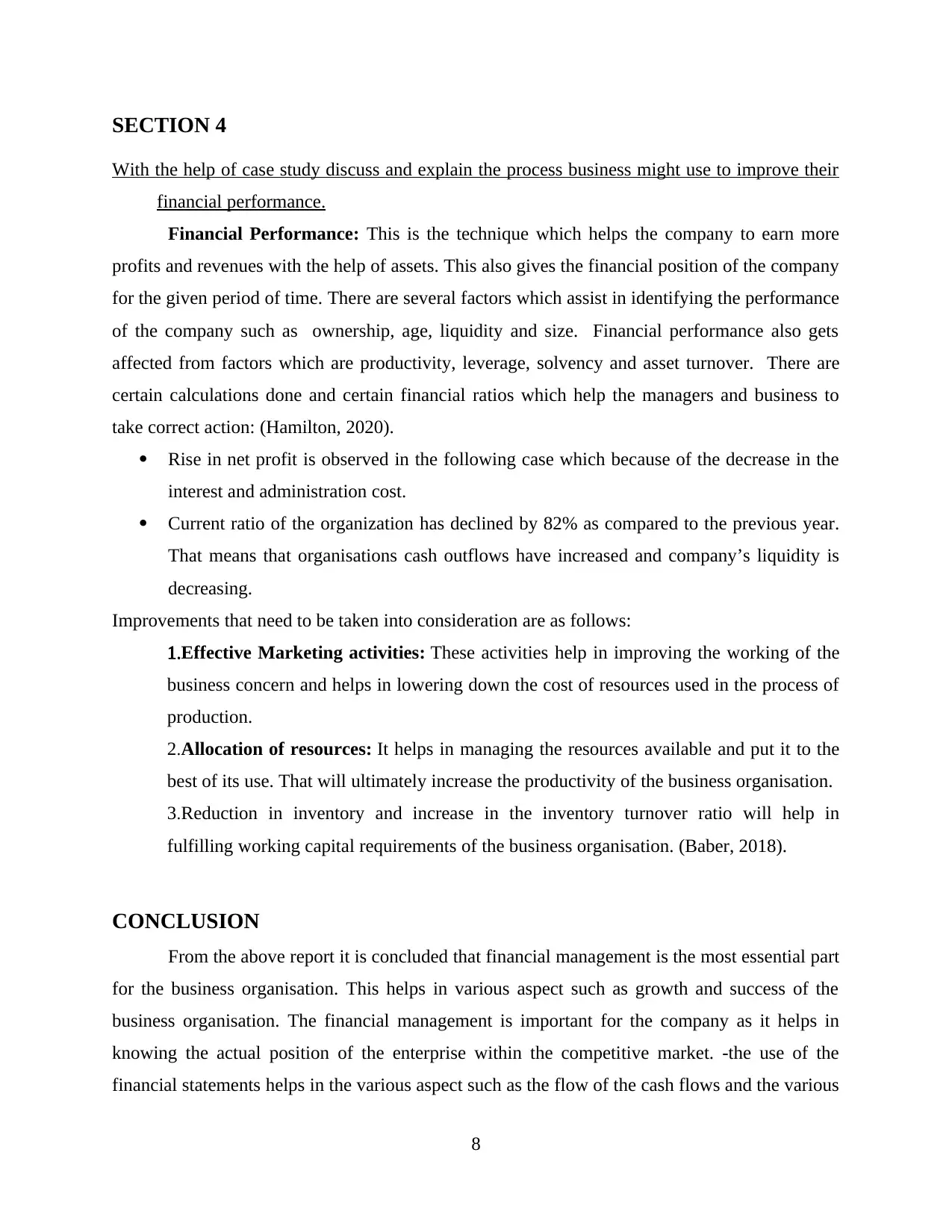
SECTION 4
With the help of case study discuss and explain the process business might use to improve their
financial performance.
Financial Performance: This is the technique which helps the company to earn more
profits and revenues with the help of assets. This also gives the financial position of the company
for the given period of time. There are several factors which assist in identifying the performance
of the company such as ownership, age, liquidity and size. Financial performance also gets
affected from factors which are productivity, leverage, solvency and asset turnover. There are
certain calculations done and certain financial ratios which help the managers and business to
take correct action: (Hamilton, 2020).
Rise in net profit is observed in the following case which because of the decrease in the
interest and administration cost.
Current ratio of the organization has declined by 82% as compared to the previous year.
That means that organisations cash outflows have increased and company’s liquidity is
decreasing.
Improvements that need to be taken into consideration are as follows:
1.Effective Marketing activities: These activities help in improving the working of the
business concern and helps in lowering down the cost of resources used in the process of
production.
2.Allocation of resources: It helps in managing the resources available and put it to the
best of its use. That will ultimately increase the productivity of the business organisation.
3.Reduction in inventory and increase in the inventory turnover ratio will help in
fulfilling working capital requirements of the business organisation. (Baber, 2018).
CONCLUSION
From the above report it is concluded that financial management is the most essential part
for the business organisation. This helps in various aspect such as growth and success of the
business organisation. The financial management is important for the company as it helps in
knowing the actual position of the enterprise within the competitive market. -the use of the
financial statements helps in the various aspect such as the flow of the cash flows and the various
8
With the help of case study discuss and explain the process business might use to improve their
financial performance.
Financial Performance: This is the technique which helps the company to earn more
profits and revenues with the help of assets. This also gives the financial position of the company
for the given period of time. There are several factors which assist in identifying the performance
of the company such as ownership, age, liquidity and size. Financial performance also gets
affected from factors which are productivity, leverage, solvency and asset turnover. There are
certain calculations done and certain financial ratios which help the managers and business to
take correct action: (Hamilton, 2020).
Rise in net profit is observed in the following case which because of the decrease in the
interest and administration cost.
Current ratio of the organization has declined by 82% as compared to the previous year.
That means that organisations cash outflows have increased and company’s liquidity is
decreasing.
Improvements that need to be taken into consideration are as follows:
1.Effective Marketing activities: These activities help in improving the working of the
business concern and helps in lowering down the cost of resources used in the process of
production.
2.Allocation of resources: It helps in managing the resources available and put it to the
best of its use. That will ultimately increase the productivity of the business organisation.
3.Reduction in inventory and increase in the inventory turnover ratio will help in
fulfilling working capital requirements of the business organisation. (Baber, 2018).
CONCLUSION
From the above report it is concluded that financial management is the most essential part
for the business organisation. This helps in various aspect such as growth and success of the
business organisation. The financial management is important for the company as it helps in
knowing the actual position of the enterprise within the competitive market. -the use of the
financial statements helps in the various aspect such as the flow of the cash flows and the various
8
Paraphrase This Document
Need a fresh take? Get an instant paraphrase of this document with our AI Paraphraser

inflow of cash within the organisation. The different types of ratios which is analysed helps in
knowing the position o0f the company.
9
knowing the position o0f the company.
9
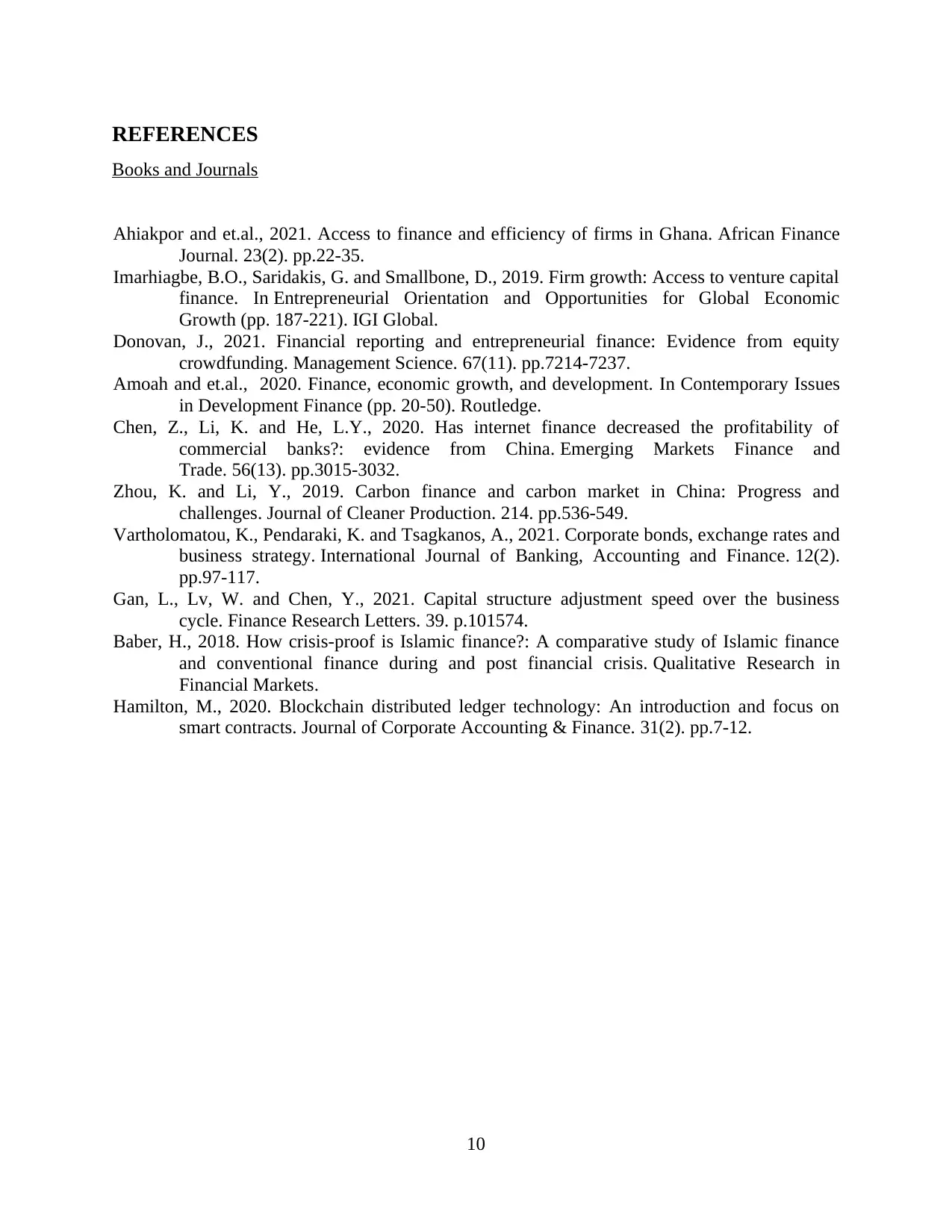
REFERENCES
Books and Journals
Ahiakpor and et.al., 2021. Access to finance and efficiency of firms in Ghana. African Finance
Journal. 23(2). pp.22-35.
Imarhiagbe, B.O., Saridakis, G. and Smallbone, D., 2019. Firm growth: Access to venture capital
finance. In Entrepreneurial Orientation and Opportunities for Global Economic
Growth (pp. 187-221). IGI Global.
Donovan, J., 2021. Financial reporting and entrepreneurial finance: Evidence from equity
crowdfunding. Management Science. 67(11). pp.7214-7237.
Amoah and et.al., 2020. Finance, economic growth, and development. In Contemporary Issues
in Development Finance (pp. 20-50). Routledge.
Chen, Z., Li, K. and He, L.Y., 2020. Has internet finance decreased the profitability of
commercial banks?: evidence from China. Emerging Markets Finance and
Trade. 56(13). pp.3015-3032.
Zhou, K. and Li, Y., 2019. Carbon finance and carbon market in China: Progress and
challenges. Journal of Cleaner Production. 214. pp.536-549.
Vartholomatou, K., Pendaraki, K. and Tsagkanos, A., 2021. Corporate bonds, exchange rates and
business strategy. International Journal of Banking, Accounting and Finance. 12(2).
pp.97-117.
Gan, L., Lv, W. and Chen, Y., 2021. Capital structure adjustment speed over the business
cycle. Finance Research Letters. 39. p.101574.
Baber, H., 2018. How crisis-proof is Islamic finance?: A comparative study of Islamic finance
and conventional finance during and post financial crisis. Qualitative Research in
Financial Markets.
Hamilton, M., 2020. Blockchain distributed ledger technology: An introduction and focus on
smart contracts. Journal of Corporate Accounting & Finance. 31(2). pp.7-12.
10
Books and Journals
Ahiakpor and et.al., 2021. Access to finance and efficiency of firms in Ghana. African Finance
Journal. 23(2). pp.22-35.
Imarhiagbe, B.O., Saridakis, G. and Smallbone, D., 2019. Firm growth: Access to venture capital
finance. In Entrepreneurial Orientation and Opportunities for Global Economic
Growth (pp. 187-221). IGI Global.
Donovan, J., 2021. Financial reporting and entrepreneurial finance: Evidence from equity
crowdfunding. Management Science. 67(11). pp.7214-7237.
Amoah and et.al., 2020. Finance, economic growth, and development. In Contemporary Issues
in Development Finance (pp. 20-50). Routledge.
Chen, Z., Li, K. and He, L.Y., 2020. Has internet finance decreased the profitability of
commercial banks?: evidence from China. Emerging Markets Finance and
Trade. 56(13). pp.3015-3032.
Zhou, K. and Li, Y., 2019. Carbon finance and carbon market in China: Progress and
challenges. Journal of Cleaner Production. 214. pp.536-549.
Vartholomatou, K., Pendaraki, K. and Tsagkanos, A., 2021. Corporate bonds, exchange rates and
business strategy. International Journal of Banking, Accounting and Finance. 12(2).
pp.97-117.
Gan, L., Lv, W. and Chen, Y., 2021. Capital structure adjustment speed over the business
cycle. Finance Research Letters. 39. p.101574.
Baber, H., 2018. How crisis-proof is Islamic finance?: A comparative study of Islamic finance
and conventional finance during and post financial crisis. Qualitative Research in
Financial Markets.
Hamilton, M., 2020. Blockchain distributed ledger technology: An introduction and focus on
smart contracts. Journal of Corporate Accounting & Finance. 31(2). pp.7-12.
10
⊘ This is a preview!⊘
Do you want full access?
Subscribe today to unlock all pages.

Trusted by 1+ million students worldwide
1 out of 12
Related Documents
Your All-in-One AI-Powered Toolkit for Academic Success.
+13062052269
info@desklib.com
Available 24*7 on WhatsApp / Email
![[object Object]](/_next/static/media/star-bottom.7253800d.svg)
Unlock your academic potential
Copyright © 2020–2025 A2Z Services. All Rights Reserved. Developed and managed by ZUCOL.


